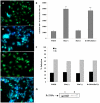Inhibition of the Plasma-Membrane-Associated Serine Protease Cathepsin G by Mycobacterium tuberculosis Rv3364c Suppresses Caspase-1 and Pyroptosis in Macrophages
- PMID: 22275911
- PMCID: PMC3257866
- DOI: 10.3389/fmicb.2011.00281
Inhibition of the Plasma-Membrane-Associated Serine Protease Cathepsin G by Mycobacterium tuberculosis Rv3364c Suppresses Caspase-1 and Pyroptosis in Macrophages
Abstract
Tuberculosis is a disease associated with the infection of a great part of the world's population and is responsible for the death of two to three million people annually. Mycobacterium tuberculosis infects macrophages and subverts its mechanisms of killing. The pathogen suppresses macrophage apoptosis by many different mechanisms. We describe that, upon uptake by macrophages, M. tuberculosis overexpresses an operon Rv3361c-Rv3365c and secretes Rv3364c. The Rv3365c knockout strain is deficient in apoptosis inhibition. The Rv3364c protein binds to the serine protease cathepsin G on the membrane, inhibiting its enzymatic activity and the downstream activation of caspase-1-dependent apoptosis. In summary, M. tuberculosis prevents macrophage pyroptosis by a novel mechanism involving cytoplasmic surveillance proteins.
Keywords: Mycobacterium tuberculosis; apoptosis; caspase-1-dependent; inhibition; macrophages; pyroptosis.
Figures







Similar articles
-
Caspase-3-independent apoptotic pathways contribute to interleukin-32γ-mediated control of Mycobacterium tuberculosis infection in THP-1 cells.BMC Microbiol. 2015 Feb 21;15:39. doi: 10.1186/s12866-015-0366-z. BMC Microbiol. 2015. PMID: 25887904 Free PMC article.
-
Human macrophages infected with a high burden of ESAT-6-expressing M. tuberculosis undergo caspase-1- and cathepsin B-independent necrosis.PLoS One. 2011;6(5):e20302. doi: 10.1371/journal.pone.0020302. Epub 2011 May 26. PLoS One. 2011. PMID: 21637850 Free PMC article.
-
Macrophage activation redirects yersinia-infected host cell death from apoptosis to caspase-1-dependent pyroptosis.PLoS Pathog. 2007 Nov;3(11):e161. doi: 10.1371/journal.ppat.0030161. PLoS Pathog. 2007. PMID: 17983266 Free PMC article.
-
Cell death at the cross roads of host-pathogen interaction in Mycobacterium tuberculosis infection.Tuberculosis (Edinb). 2018 Dec;113:99-121. doi: 10.1016/j.tube.2018.09.007. Epub 2018 Sep 29. Tuberculosis (Edinb). 2018. PMID: 30514519 Review.
-
Macrophages and tuberculosis.Curr Opin Hematol. 1998 Jan;5(1):72-8. doi: 10.1097/00062752-199801000-00012. Curr Opin Hematol. 1998. PMID: 9515206 Review.
Cited by
-
Cathepsins and Their Endogenous Inhibitors in Host Defense During Mycobacterium tuberculosis and HIV Infection.Front Immunol. 2021 Aug 4;12:726984. doi: 10.3389/fimmu.2021.726984. eCollection 2021. Front Immunol. 2021. PMID: 34421929 Free PMC article. Review.
-
Virulence Factors of Mycobacterium tuberculosis as Modulators of Cell Death Mechanisms.Pathogens. 2023 Jun 18;12(6):839. doi: 10.3390/pathogens12060839. Pathogens. 2023. PMID: 37375529 Free PMC article. Review.
-
Activation and evasion of inflammasomes during viral and microbial infection.Cell Mol Life Sci. 2025 Jan 21;82(1):56. doi: 10.1007/s00018-025-05575-2. Cell Mol Life Sci. 2025. PMID: 39833559 Free PMC article. Review.
-
Persistence of the bacterial pathogen Granulibacter bethesdensis in chronic granulomatous disease monocytes and macrophages lacking a functional NADPH oxidase.J Immunol. 2013 Sep 15;191(6):3297-307. doi: 10.4049/jimmunol.1300200. Epub 2013 Aug 16. J Immunol. 2013. PMID: 23956436 Free PMC article.
-
Mycobacterium tuberculosis Rv2387 Facilitates Mycobacterial Survival by Silencing TLR2/p38/JNK Signaling.Pathogens. 2022 Aug 27;11(9):981. doi: 10.3390/pathogens11090981. Pathogens. 2022. PMID: 36145413 Free PMC article.
References
-
- Applied-Biosystems (1997). Relative quantitation of gene expression. ABI PRISM 7700 sequence detection system user bulletin #2. London: ABI Company Publication
-
- Averette K. M., Pratt M. R., Yang Y., Bassilian S., Whitelegge J. P., Loo J. A., Muir T. W., Bradley K. A. (2009). Anthrax lethal toxin induced lysosomal membrane permeabilization and cytosolic cathepsin release is Nlrp1b/Nalp1b-dependent. PLoS ONE 4, e7913.10.1371/journal.pone.0007913 - DOI - PMC - PubMed
Grants and funding
LinkOut - more resources
Full Text Sources
Molecular Biology Databases

